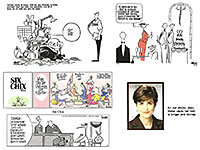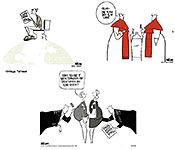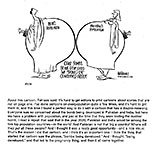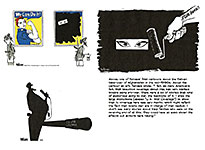 |
|||||
|
At the 71st annual convention of the National Cartoonists Society, held, this year, in Portland, Oregon, May 25-28, editorial cartoonist Ann Telnaes won the Reubens trophy awarded to the Cartoonist of the Year. It was a triumph in at least two ways. First, Telnaes is only the fourth woman cartoonist to have won the Reuben in the Society’s 72-year male-dominated history. Second, she’s only the 9th editorial cartoonist to have won. Usually, Reuben winners are syndicated comic strip cartoonists; of the 72 winners (in two years, a tie resulted in two winners), only 21 have been non-syndicated cartoonists. Despite an attempt to embrace cartoonists in all cartooning endeavors, NCS has fallen short spectacularly. No one working in comic books won the Reuben until Will Eisner did in 1998—52 years after the Society started giving the award—for the Spirit, which Eisner no longer produced on a regular basis. And until Roz Chast won in 2014, no cartoonist working in magazine gag cartooning had won. Ann Telnaes and I have been friends for nearly 20 years. Our friendship began, for me, with admiration for her work, a feeling that has only increased over the years. A Pulitzer Prize winning editorial cartoonist (2001), Telnaes deploys not only a considerable talent as an artist but breadth of vision and a discerning eye as an observer of public affairs. She routinely sees aspects of subjects that often evade the attention of her colleagues. She has regularly tackled national and international issues from a woman’s perspective, usually bringing the issues into sharper focus by giving them a larger context than most editorial cartoonists achieve. Although she is one of only a handful of female editorial cartoonists, her perspective is not exclusively feminist: it is overwhelmingly humanist. Characteristically, her editorial cartoons do not pull their punches: she aims to ridicule political hypocrisy out of existence or to illuminate the darker, secretive or ignorant corners of government action (or inaction), and she does so in vivid, memorable visual metaphors that serve as a spotlight for public awareness and therefore as a goad to discussion and thought and perhaps to change and remedy. Her drawing style is not like any other editoonist’s. Her pictures reveal her training in animation. Born in Sweden, Telnaes became a U.S. citizen at about the age of thirteen when her parents did. Her Norwegian father worked for IBM, and the family was transferred around a good deal. They lived in this country until she was six, left, then returned three years later. At Arizona State University, she majored in art with a minor in journalism. At the time, she had no interest in editorial cartooning. When she realized that if she wanted to work in some sort of commercial art, she’d better go to art school; she left ASU after two-and-a-half years and enrolled at the Califorinia Institute of the Arts near Los Angeles. Cal Art has its roots in the Chouinard Art School, an early training ground for Disney Studio, and offers, even today, an animation program geared to the needs of Disney. Telnaes majored in character animation, graduated with a BSA in 1984, and freelanced in animation for several years—sometimes for Disney, sometimes for smaller studios. She eventually applied to the Imagineering division at Disney. “It took me a little while, but I got in,” she says. She worked there for six years, freelancing on the side. Then came Tiananmen Square, the 1989 Chinese crackdown on dissent that was televised worldwide. And after that, editorial cartooning—even though she had no previous ambition in that direction. “I was working on something one night, and I watched the Tiananmen Square massacres on tv, which had a big effect on me. I did a cartoon. I never did anything with it: it was a horribly bloody, yucky mess that I did, but I just had to do it. And after that, I kind of played around with a few more, but I didn’t approach it seriously until the Anita Hill hearings.” She sent her cartoons around to newspapers, selling one now and again. “I started because the issues motivated me,” she says. “And then I started getting published regularly during the 1992 Republican Convention. And I’ve been doing it since.” When she won the Pulitzer, she was the first editoonist since Bill Mauldin in 1945 to win without having a home-base newspaper. In early 2000, she joined five other women cartoonists to produce a syndicated comic strip at the invitation of King Features. Dubbed (with a curiously sexist insensitivity) Six Chix, the strip stresses feminine points of view as the six chix rotate through the feature, each doing one day every week. Said Telnaes: “Six Chix does allow me to do subject matter which is more ‘comedic’ (although I don't think I'm very funny). Since I tend to put some sort of commentary in most everything I do, I still look at my work in Six Chix as a type of social commentary, albeit a bit more subtle than my editorial cartoons. Six Chix gives me an opportunity to do more women-oriented pieces and other subjects which I might not necessarily address in my editorial cartoons. I find my biggest problem when I'm working on Six Chix is ‘lightening up’—I'm always trying to turn it into an editorial cartoon!” Telnaes is a feminist but not a member of a club. “I’d say that women’s issues on the whole are not reported enough,” she says. “Just look at your newspaper’s front page—how many front page stories are about women? Women make up more than half of the U.S. population so it’s not a special interest. Everyone should be concerned about issues that affect women because everyone has a mother, a sister, a wife, a girlfriend, a daughter. “I happen to think that a lot of the political situations we’re in right now, internationally [circa 2004, when she said all this], are directly affected by women’s economic and social situations. Everyone now is familiar with Afghanistan when the Taliban ruled. This isn’t something that came out of September 11. “This started back in 1996 when the Taliban took control and established rules which put women at an extreme disadvantage. They weren’t allowed to work, go to school, get medical attention—because the Taliban wouldn’t allow women to be seen by men, and all the doctors were men, of course, since women weren’t allowed to work. “Can you imagine our government ignoring, for so many years, a regime which curtailed men’s rights to that extreme?” Telnaes left the Six Chix strip after a relatively short time to concentrate on editooning for the Washington Post. When some editoonists began animating some of their cartoons for their newspapers’ websites, Telnaes was better qualified than any of her colleagues. For the last several years, she has been on staff at the Post, for which she produces an animated editorial cartoon several times a week and/or sketches and static editoons. She is, at present, president of the Association of American Editorial Cartoonists. And here, at your eye’s elbow, are some samples of her work.
The other four nominees for the Reuben were alt-cartooner Lynda Barry, Hilary Price (Rhymes with Orange), Mark Tatulli (Heart of the City and Lio), and Stephan Pastis (Pearls Before Swine). Price has been nominated before and this is Pastis’ ninth try. Always a bridesmaid. The record in this category is held by Garry Trudeau, whose Doonesbury was nominated sixteen times. Pastis may take comfort in that (although his Pearls is no Doonesbury). While Barry’s comedy is often a telling example of cartooning artistry (and her insight into the creative process is keen) and the work of the other three is of high professional caliber, none of the four rise to the level of excellence that Telnaes achieves time after time with virtually every cartoon she produces. And her animated editoons are particularly distinguished. Although other editorial cartoonists make characters move, in Telnaes’ animations, the punchlines are delivered by the movement, thereby making maximum use of the medium. It is generally accepted that winning a Reuben is an honor, but Telnaes' win this year elevates the status of the Reuben—not the other way around. The
Reuben trophy, incidentally, was crafted by Rube Goldberg, the first
president of NCS, who thought, at the time, he was making a lamp.
The Other Rubes. In addition to awarding some deserving ink-stained soul the Reuben trophy as Cartoonist of the Year, NCS also doles out awards for cartooning in various “divisions” of the craft—best comic strip, best magazine gag cartoon, best comic book, etc. These awards were termed “Division Awards” for most of their history, but many cartooners called them “Reubens” even though they aren’t Reubens: there is only one Reuben, and that’s the one that goes to the Cartoonist of the Year. Still, the erroneous nomenclature persisted. Surrendering to the inevitable, NCS decided a couple years ago to call the Division Awards “Silver Reubens.” That seems dumb to me because making them “silver” gives them a seeming value in excess of that enjoyed by the simple, unadorned nonmetallic “Reuben.” As if to make up for this slight, this year’s trophy was gold. But it wasn’t called the Golden Reuben. Thankfully. This year’s program called the erstwhile Division Awards the “Silver Reuben Divisional Awards,” attempting a course correction by piling up all the known names of the thing. I say call them “Rubes,” a name that perpetuates the Reuben but differentiates the division awards from the Reuben by deploying the short, nick-name version of the word. That’s what I say, but they never ask me. Fifteen Rubes have been conferred for the last several years, and I’m listing the divisions below and all the nominees for each because being a nominee is almost as honorable as winning; the winners are indicated with an asterisk (*) before their names. Newspaper Comic Strip: Brian Crane (Pickles), *Steve Kelley and *Jeff Parker (Dustin), Terri Libenson (Pajama Diaries). Newspaper Panel Cartoon: Dave Blazek (Loose Parts), *Nick Galifianakis (Nick and Zuzu), Mark Parisi (Off the Mark). Editorial Cartoon: Ruben Bolling, *Michael Luckovich, Jen Sorensen Comic Book: *Max Sarin and Liz Fleming (Giant Days), Gabriel Rodriguez (Locke & Key), Stan Sakai (Usagi Yojimbo) Magazine Gag Cartooning: Pat Byrnes, Joe Dator, *Will McPhail (video) Greeting Card: Dave Blazek, Maria Scrivan, *Debbie Tomassi Advertising/Product Illustration: Anton Emdin, *Luke McGarry, Dave Whamond Newspaper Illustration: Anton Emdin, Glen LeLievre, *David Rowe (video) Book Illustration: Mike Lester (Amazon Rapids Series), Mark Tatulli (Daydreaming), *Dave Whamond (Braids) Feature Animation: Eric Goldberg, Character Animation (“Moana”), *Cory Loftis, Character Design (“Zootopia”), Erick Oh, Character Animation (“Finding Dory”) Television Animation: Eric Goldberg (“The Simpsons”), Steve Lambe and Alan Stewart (“Atomic Puppet”), *Chris Saving (“The Loud House”; video) Graphic Novel: Jules Feiffer (Cousin Joseph), *Rick Geary (Black Dahlia; video), Bryan Talbot (The Red Virgin and the Vision of Utopia) Magazine Feature/Magazine Illustration: *Jon Adams (video), Teresa Burns Parkhurst, Peter Kuper Online Comics, Short Form: Sarah Anderson (Sarah’s Scribbles), *Ruben Bolling (Donald & John), Dave Kellett (Sheldon) Online Comics, Long Form: Meredith Gran (Octopus Pie), Kathleen Jacques (Band by Band), *Ngozi Ukazu (OMG Check Please)
Irks and Crotchets. As usual, aspects of the awards rub me the wrong way. F’instance—Jules Feiffer didn’t get a Rube for Cousin Joseph. Rick Geary, who won that division, is certainly a worthy winner, and he’s done many more graphic novels (historical graphic novels) than Feiffer’s two; so Geary deserves the Rube. But Feiffer deserves the Reuben. Feiffer has done more to shape comics than most cartoonists, and he should have been awarded the Reuben years ago. But with its legendary institutional myopia, NCS continued to keep its head firmly inserted in the nearest sand pile, ignoring what is happening all around it. It took years before the humble comic book was recognized by instituting a division award for the genre. And online cartooning has only recently been recognized. Then we have Luke McGarry, whose publicity claims he’s the most “sought after” animator in the Los Angeles area—you know, the area that encompasses Burbank and the Disney Studio, fraught with animators but Luke is more sought after than any of them. Still, Luke is one of the twin sons of Steve McGarry, who is a past prez of NCS and chair of the NCS Foundation. And the only magazine gag cartoonists up for a Rube all cartoon for The New Yorker, as if there are no other outlets for magazine gag cartooning in the nation. Since the death of Playboy, that may be vaguely accurate—The New Yorker is the only major outlet left—but dozens of other magazines, usually specialty mags, still use cartoons. And if you want their names, subscribe to Gag Recap at its website. The comic book division, a late comer to the Rube category, is still not well represented. The jurying seems determined to avoid naming any comic book published by Marvel, DC, or Dark Horse. Why? The persistence of an antique snobbery that, since the early days of NCS, sees comic books as committee projects, not artistic products of individual accomplishment, and hence, not worthy of recognition. So the committee-produced works from the Big Three are ignored. Stan Sakai and Gabriel Rodriguez are deserving of the recognition, having done considerable work, but Sarin and Fleming are newcomers: the book they won for, Giant Days, debuted in 2015. They have no body of work of any significance, it seems to me. Sarin drew a few issues, and Fleming inked his work. The creator and writer of the title, John Allison, is not mentioned. Ergo, validation of the NCS attitude about comic books. To whom do we give the award? Oddly, the packet we were all issued upon checking in to the convention contained an issue of Giant Days —the 2016 “Holiday Special No.1"—but it was not produced by Sarin and Fleming. A little strange. The story, a succession of slap-dash giggly incidents given seeming import far beyond the surface triviality , involves four girls who might be teenagers or maybe college students, talking about friendship. Fairly juvenile stuff, both characters and comedy. One of the girls, Esther, is provoked by a chant the others sing to her: “Esther! Esther! Show us your arse! Esther! Show us your arse!” To which she responds: “Alas, I have had some wines and can no longer find my arse with both hands.” On the next page, she gets sick and vomits into a bush. “What did that poor bush ever do to you?” asks a friend. Allison is British, and Britishisms have penetrated: the aforementioned “arse” and, later, “crisps” for potato chips. Phooey. I can’t imagine mature American cartoonists jurying comic books and deciding this adolescent rubbish is worthy of a Rube. But all this nit-picking is, perhaps, beside the point. The Rubes, the NCS Division Awards, are not terribly well-regarded by the profession as a whole. The Reuben is, but not the Rubes. And how do we know this? Because only a third of those who got a Rube showed up for the presentation ceremony, the Reuben Banquet. Only the boldfaced asterisked names in the foregoing listing were present. The others—11 of the 17 individuals, two thirds of the number—weren’t there, didn’t bother to show up. Seven of them, admittedly, thought enough of the possible distinction to send a video of themselves expressing gratitude and/or amazement. Not even all the nominees for the Reuben were there. Stephan Pastis didn’t bother. But I can understand why: he’s been up for the Reuben eight times before without winning and probably didn’t think he’d win this time either. Why show up then? But if, as I suppose, the prestige of the “Division Awards” has declined in recent years, so too have newspaper comics, which were the abode of most of the founders of NCS. Oddly, the comic book is now the prestige home of cartooning—thanks, chiefly, to the rise of the graphic novel—but NCS was late in recognizing the graphic novel (as it has been in noticing online cartooning). The Reuben, however—that trophy of stacked nude cartoon men—still commands attention. We should be thankful and not full of irks and crotchets. In our next Opus, we’ll cover a few other aspects of the NCS Reubens Weekend.
To find out about Harv's books, click here. |
|||||

send e-mail to R.C. Harvey Art of the Comic Book - Art of the Funnies - Accidental Ambassador Gordo - reviews - order form - Harv's Hindsights - main page |





